Yamaha Audio GX-50 User Manual
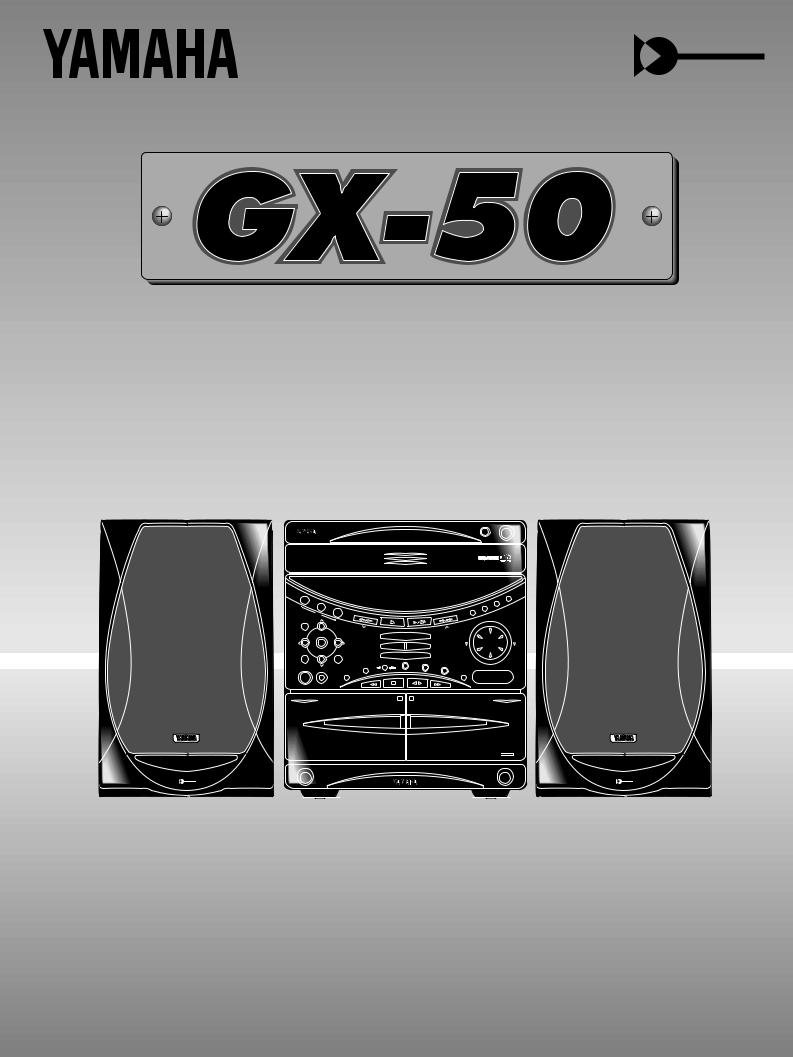
Active Servo
Technology
Natural Sound Mini Component System
Cha”ne Mini de la sŽrie ÒNatural SoundÓ
MINI COMPONENT SYSTEM GX–50
1
2
DISC
LOCATION
MUSIC
USER
POWER
PHONES
DISC CHANGE
OPEN/CLOSE
|
PTY |
SEEK |
|
|
DISPLAY |
|
|
|
START |
|
|
3 |
MODE |
|
EDIT |
|
|
|
|
|
|
||
|
PS/PTY/RT/CT REPEAT |
|
|
|
|
|
FREQ |
|
|
|
|
|
RANDOM |
|
VOLUME |
||
PRESET/TUNING |
A/B/C/D/E |
|
|
|
|
CD |
|
|
|
|
|
|
DOWN |
|
|
|
UP |
TUNER |
AUX |
|
|
|
|
BAND |
|
|
|
|
|
MEMORY |
|
|
|
|
|
TAPE 1/2 |
|
|
|
|
|
REC/PAUSE |
NORMAL |
|
|
|
|
MODE |
|
|
|
|
|
DOLBY NR |
HIGH |
|
|
|
|
|
DUBBING |
|
|
|
|
TIMER REC |
|
|
|
|
|
AUTO/MAN’L |
MEMORY |
|
|
|
|
|
|
|
Active Servo |
|
|
|
|
|
Technology |
|
|
TIMER |
TIME ADJ |
|
|
|
|
HOUR |
MIN |
|
|
|
|
PLAYBACK 1 2 REC/PLAYBACK

 DOLBY B NR
DOLBY B NR
EJECT |
EJECT |
Active Servo |
Active Servo |
Technology |
Technology |
OWNER‘S MANUAL
MODE D‘EMPLOI
Downloaded from: http://www.usersmanualguide.com/
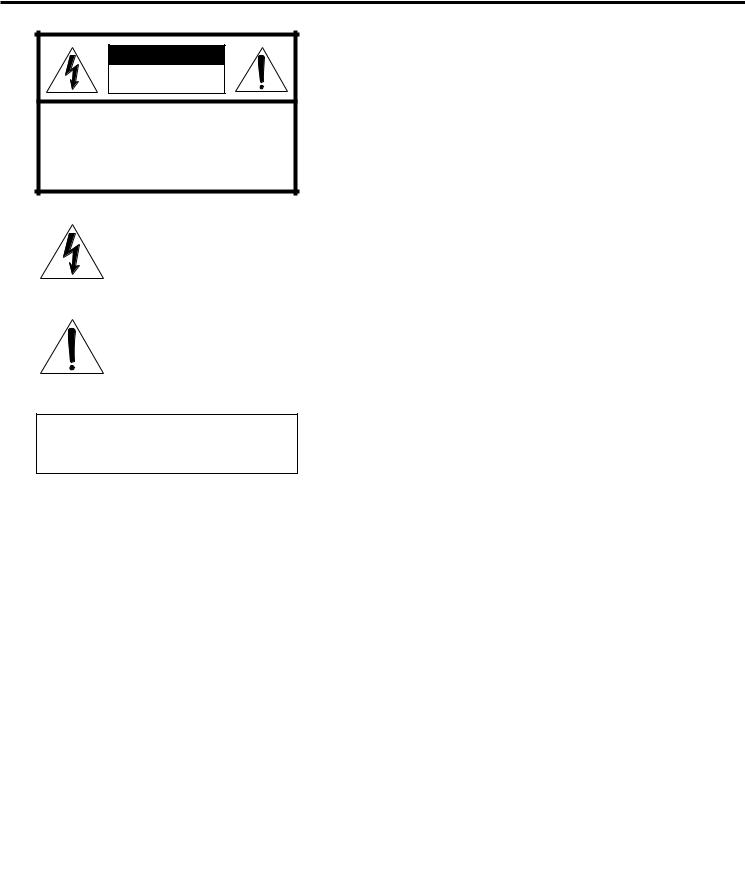
SAFETY INSTRUCTIONS
CAUTION
R I S K O F E L E C T R I C S H O C K
D O N O T O P E N
CAUTION: TO REDUCE THE RISK OF
ELECTRIC SHOCK, DO NOT REMOVE
COVER (OR BACK). NO USER-SERVICEABLE
PARTS INSIDE. REFER SERVICING TO
QUALIFIED SERVICE PERSONNEL.
• Explanation of Graphical Symbols
The lightning flash with arrowhead symbol, within an equilateral triangle, is intended to alert you to the presence of uninsulated “dangerous voltage” within the product’s enclosure that may be of sufficient magnitude to constitute a risk of electric shock to persons.
The exclamation point within an equilateral triangle is intended to alert you to the presence of important operating and maintenance (servicing) instructions in the literature accompanying the appliance.
WARNING
TO REDUCE THE RISK OF FIRE OR
ELECTRIC SHOCK, DO NOT EXPOSE THIS
UNIT TO RAIN OR MOISTURE.
1Read Instructions – All the safety and operating instructions should be read before the unit is operated.
2Retain Instructions – The safety and operating instructions should be retained for future reference.
3Heed Warnings – All warnings on the unit and in the operating instructions should be adhered to.
4Follow Instructions – All operating and other instructions should be followed.
5Water and Moisture – The unit should not be used near water – for example, near a bathtub, washbowl, kitchen sink, laundry tub, in a wet basement, or near a swimming pool, etc.
6Carts and Stands – The unit should be used only with a cart or stand that is recommended by the manufacturer.
6A A unit and cart combination should be moved with care. Quick stops, excessive force, and uneven surfaces may cause the unit and
cart combination to overturn.
7Wall or Ceiling Mounting – The unit should be mounted to a wall or ceiling only as recommended by the manufacturer.
8Ventilation – The unit should be situated so that its location or position does not interfere with its proper ventilation. For example, the unit should not be situated on a bed, sofa, rug, or similar surface, that may block the ventilation openings; or placed in a built-in installation, such as a bookcase or cabinet that may impede the flow of air through the ventilation openings.
9Heat – The unit should be situated away from heat sources such as radiators, stoves, or other appliances that produce heat.
10Power Sources – The unit should be connected to a power supply only of the type described in the operating instructions or as marked on the unit.
11Power-Cord Protection – Power-supply cords should be routed so that they are not likely to be walked on or pinched by items placed upon or against them, paying particular attention to cords at plugs, convenience receptacles, and the point where they exit from the unit.
12Cleaning – The unit should be cleaned only as recommended by the manufacturer.
13Nonuse Periods – The power cord of the unit should be unplugged from the outlet when left unused for a long period of time.
14Object and Liquid Entry – Care should be taken so that objects do not fall into and liquids are not spilled into the inside of the unit.
15Damage Requiring Service – The unit should be serviced by qualified service personnel when:
A.The power-supply cord or the plug has been damaged; or
B.Objects have fallen, or liquid has been spilled into the unit; or
C.The unit has been exposed to rain; or
D.The unit does not appear to operate normally or exhibits a marked change in performance; or
E.The unit has been dropped, or the cabinet damaged.
16Servicing – The user should not attempt to service the unit beyond those means described in the operating instructions. All other servicing should be referred to qualified service personnel.
17Power Lines – An outdoor antenna should be located away from power lines.
18Grounding or Polarization – Precautions should be taken so that the grounding or polarization is not defeated.
2
Downloaded from: http://www.usersmanualguide.com/
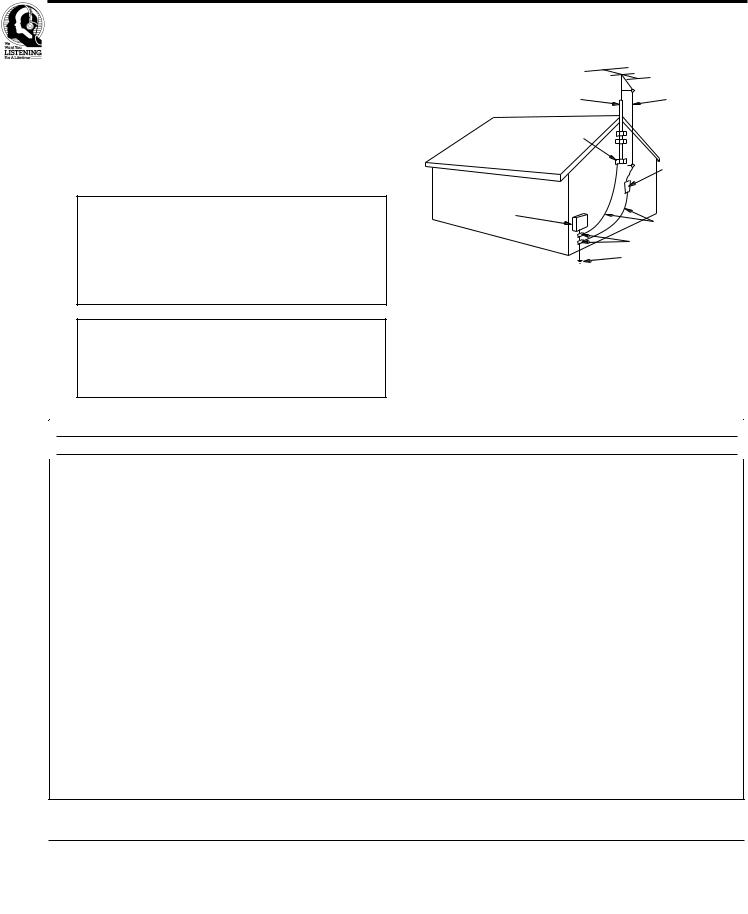
19For US customers only:
Outdoor Antenna Grounding – If an outside antenna is connected to this unit, be sure the antenna system is grounded so as to provide some protection against voltage surges and built-up static charges. Article 810 of the National Electrical Code, ANSI/NFPA 70, provides information with regard to proper grounding of the mast and supporting structure, grounding of the lead-in wire to an antenna discharge unit, size of grounding conductors, location of antenna discharge unit, connection to grounding electrodes, and requirements for the grounding electrode.
Note to CATV system installer:
This reminder is provided to call the CATV system installer’s attention to Article 820-40 of the NEC that provides guidelines for proper grounding and, in particular, specifies that the cable ground shall be connected to the grounding system of the building, as close to the point of cable entry as practical.
EXAMPLE OF ANTENNA GROUNDING
MAST |
ANTENNA |
|
LEAD IN |
|
WIRE |
GROUND |
|
CLAMP |
|
|
ANTENNA |
|
DISCHARGE UNIT |
|
(NEC SECTION 810–20) |
ELECTRIC |
|
SERVICE |
|
EQUIPMENT |
GROUNDING CONDUCTORS |
|
|
|
(NEC SECTION 810–21) |
|
GROUND CLAMPS |
|
POWER SERVICE GROUNDING |
|
ELECTRODE SYSTEM |
|
(NEC ART 250. PART H) |
NEC – NATIONAL ELECTRICAL CODE |
|
SPECIAL NOTES FOR FCC COMPOSITE DEVICE (for US customers only)
This device is a composite system. The digital device component may not cause harmful interference.
FCC INFORMATION (for US customers only)
1.IMPORTANT NOTICE : DO NOT MODIFY THIS UNIT!
This product, when installed as indicated in the instructions contained in this manual, meets FCC requirements. Modifications not expressly approved by Yamaha may void your authority, granted by the FCC, to use the product.
2.IMPORTANT : When connecting this product to accessories and/or another product use only high quality shielded cables. Cable/s supplied with this product MUST be used. Follow all installation instructions. Failure to follow instructions could void your FCC authorization to use this product in the USA.
3.NOTE : This product has been tested and found to comply with the requirements listed in FCC Regulations, Part 15 for Class “B” digital devices. Compliance with these requirements provides a reasonable level of assurance that your use of this product in a residential environment will not result in harmful interference with other electronic devices.
This equipment generates/uses radio frequencies and, if not installed and used according to the instructions found in the users manual, may cause interference harmful to the operation of other electronic devices.
Compliance with FCC regulations does not guarantee that interference will not occur in all installations. If this product is found to be the source of interference, which can be determined by turning the unit “OFF” and “ON”, please try to eliminate the problem by using one of the following measures:
Relocate either this product or the device that is being affected by the interference.
Utilize power outlets that are on different branch (circuit breaker or fuse) circuits or install AC line filter/s.
In the case of radio or TV interference, relocate/reorient the antenna. If the antenna lead-in is 300 ohm ribbon lead, change the lead-in to coaxial type cable.
If these corrective measures do not produce satisfactory results, please contact the local retailer authorized to distribute this type of product. If you can not locate the appropriate retailer, please contact Yamaha Electronics Corp., U.S.A. 6660 Orangethorpe Ave, Buena Park, CA 90620.
The above statements apply ONLY to those products distributed by Yamaha Corporation of America or its subsidiaries.
We Want You Listening For A Lifetime (for US customers only)
YAMAHA and the Electronic Industries Association’s Consumer Electronics Group want you to get the most out of your equipment by playing it at a safe level. One that lets the sound come through loud and clear without annoying blaring or distortion – and, most importantly, without affecting your sensitive hearing.
Since hearing damage from loud sounds is often undetectable until it is too late, YAMAHA and the Electronic Industries Association’s Consumer Electronics Group recommend you to avoid prolonged exposure from excessive volume levels.
3
Downloaded from: http://www.usersmanualguide.com/
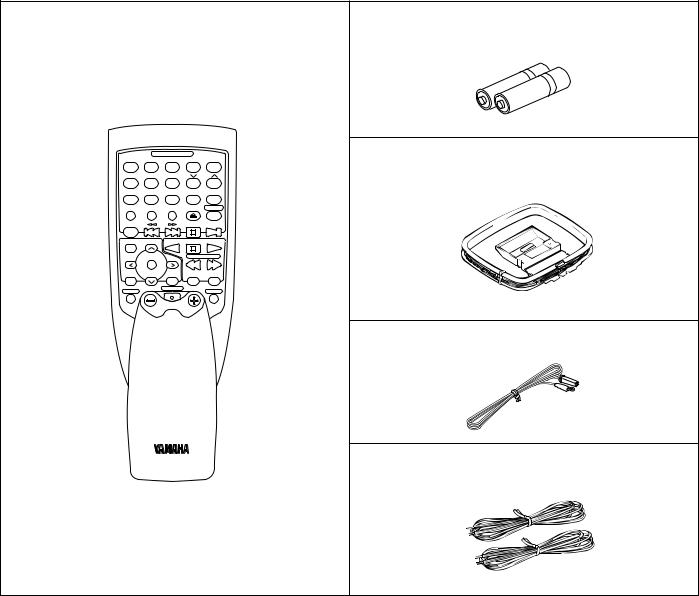
SUPPLIED ACCESSORIES ACCESSOIRES FOURNIS
●After unpacking, check that the following parts are contained.
●Après le déballage, vérifier que les pièces suivantes sont incluses.
●Remote control transmitter
●Télécommande
|
|
CD |
|
|
1 |
2 |
3 |
4 |
5 |
1 |
2 |
3 |
4 |
5 |
6 |
7 |
8 |
PRESET |
|
6 |
7 |
8 |
9 |
0 |
A |
B |
C |
D |
E |
TIME |
PROG |
TAPE |
EDIT |
+I0 |
MODE |
REPEAT |
RANDOM |
OPEN/CLOSE |
TUNER |
DISC SKIP |
|
|
STOP |
PLAY/PAUSE |
LOCATION |
|
PLAY |
STOP |
PLAY |
|
MUSIC |
|
TAPE |
|
USER |
|
FLAT |
REC/PAUSE |
DECK 1/2 |
SLEEP |
|
POWER |
|
INPUT |
|
|
|
||
VOLUME
●Batteries (size AA, UM/SUM-3, R6, HP-7)
●Piles (format AA, UM/SUM-3, R6, HP-7)
●AM (MW/LW) loop antenna
●Cadre-antenne AM (PO/GO)
●Indoor FM antenna
●Antenne intérieure FM
●Speaker cords (for NX-GX50)
●Câbles d’enceintes (pour les enceintes NX-GX50)
4
Downloaded from: http://www.usersmanualguide.com/
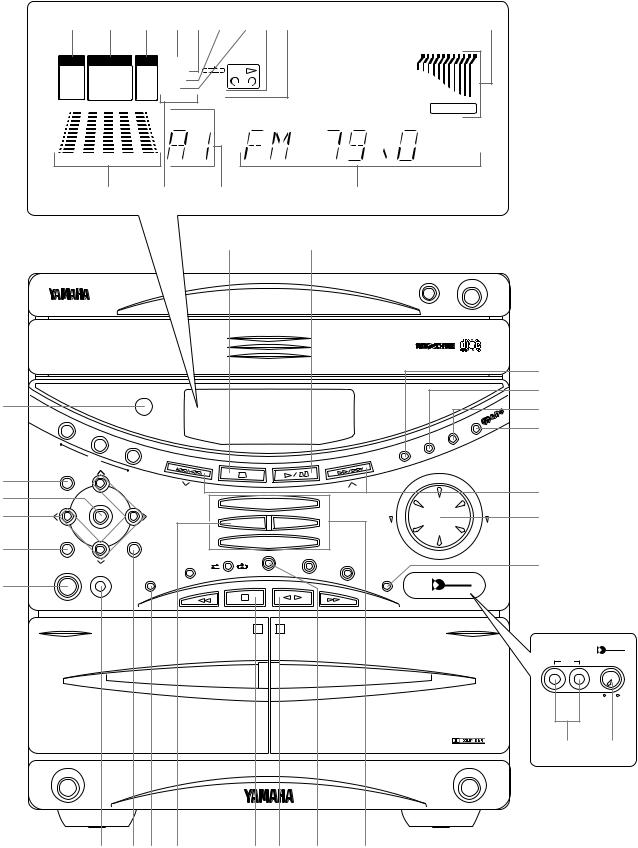
1
1 2 3 456 789 |
0 |
||||
MUSIC |
LOCATION |
USER |
MEMORY |
REC TAPE 1 2 |
|
ROCK |
ARENA |
1 |
STEREO |
|
|
BLUES |
CLUB |
2 |
TUNED |
B |
|
RAP |
STUDIO |
3 |
AUTO |
TIMER |
|
JAZZ |
KARAOKE L R |
4 |
|
||
PTY HOLD |
SLEEP DUBBING |
|
|||
|
|
|
|
NOR HIGH |
VOLUME |
|
|
|
|
|
|
|
|
|
PRESET |
|
|
|
|
|
TRACK |
T REM |
|
|
|
|
|
|
KHZ |
100 350 1K 3.5K |
10K |
|
|
MHZ |
|
A B C D
2 1
|
|
|
|
|
|
|
|
|
|
|
|
|
O |
|
3 |
|
|
|
|
|
|
|
|
|
|
|
|
N |
|
|
|
|
|
|
|
|
|
|
|
|
|
M |
|
|
|
1 |
|
|
|
|
|
|
|
|
SEEK |
|
DISPLAY |
L |
|
|
|
|
|
|
|
|
|
|
PTY |
|
|
|
||
|
|
|
|
|
|
|
|
|
|
|
|
|
||
|
|
2 |
|
|
|
|
|
|
|
|
START |
|
|
|
|
|
DISC |
3 |
|
|
|
|
|
MODE |
|
EDIT |
|
|
|
|
|
|
|
|
|
|
|
|
|
|
|
|||
|
|
|
|
|
|
|
PS/PTY/RT/CT REPEAT |
|
|
|
|
|||
|
|
|
|
|
|
|
|
|
|
|
|
|||
|
|
|
|
|
|
|
|
FREQ |
|
|
|
|
|
|
4 |
LOCATION |
|
|
|
|
|
|
RANDOM |
|
|
VOLUME |
|
|
|
5 |
|
|
|
PRESET/TUNING |
|
A/B/C/D/E |
|
|
|
|
|
K |
|
|
|
MUSIC |
|
|
|
CD |
|
|
|
|
|
|
|
|
|
6 |
|
|
|
|
|
|
|
DOWN |
|
|
|
UP |
J |
|
|
|
|
|
TUNER |
|
AUX |
|
|
|
|
|
|
||
|
|
|
|
BAND |
|
|
|
|
|
|
|
|
|
|
7 |
USER |
|
MEMORY |
|
TAPE 1/2 |
|
|
|
|
|
|
|
||
|
|
|
|
|
|
|
|
|
|
|
||||
|
|
|
MODE |
REC/PAUSE |
NORMAL |
|
|
|
|
|
I |
|
||
|
|
|
DOLBY NR |
|
|
|
HIGH |
|
|
|
|
|
|
|
|
POWER |
PHONES |
|
|
|
|
DUBBING |
|
|
|
|
|
|
|
|
|
|
|
TIMER REC |
|
|
|
|
|
|
||||
8 |
|
|
AUTO/MAN’L |
|
|
|
|
MEMORY |
|
|
|
|
|
|
|
|
|
|
|
|
|
|
|
|
Active Servo |
|
|
|
|
|
|
|
|
|
|
|
|
|
|
|
Technology |
|
|
|
|
|
|
TIMER |
|
|
|
|
TIME ADJ |
|
|
|
|
|
|
|
|
|
|
HOUR |
|
MIN |
|
|
|
|
|
|
|
|
|
|
|
|
PLAYBACK 1 |
2 REC/PLAYBACK |
|
|
|
|
|
|
|
||
|
|
|
|
|
|
|
|
|
|
|
|
|
|
Active Servo |
|
|
|
|
|
|
|
|
|
|
|
|
|
|
Technology |
|
|
|
|
|
|
|
|
|
|
|
|
|
MIC |
MIC MIXING |
|
|
|
|
|
|
|
|
|
|
|
|
|
|
MIN MAX |
|
|
|
|
|
|
|
|
|
|
|
|
|
G |
H |
|
|
EJECT |
|
|
|
|
|
|
EJECT |
|
|
|
||
|
|
9 0A B |
|
C D E |
F |
|
|
|
|
|
|
|||
Illustration: Europe model
Illustration: Modèle pour l’Europe
5
Downloaded from: http://www.usersmanualguide.com/
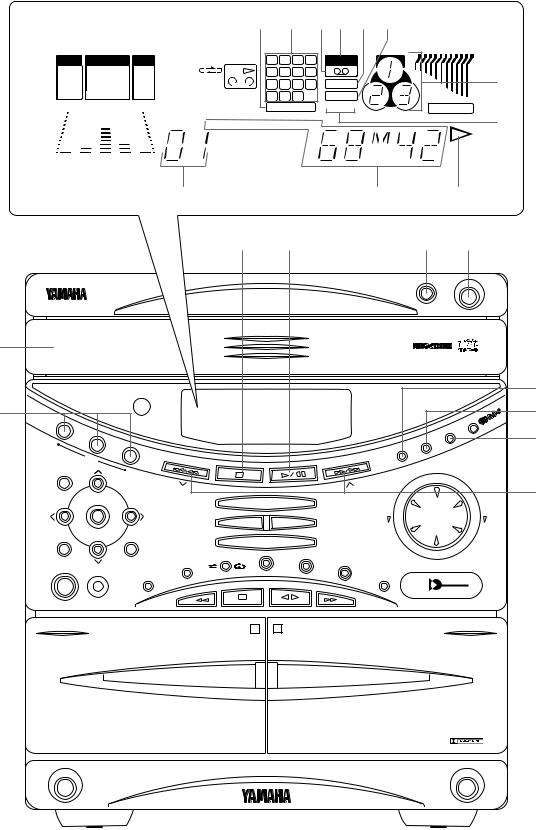
2
E F GHI J
MUSIC LOCATION |
USER |
TAPE 1 2 |
1 |
2 |
3 |
4 |
EDIT |
|
|
|||
ROCK |
|
|
|
|
|
5 |
6 |
7 |
8 |
A B |
|
O |
|
|
STUDIO |
|
|
9 |
10 11 12 |
PROG |
|
||||
|
|
|
|
|
|
13 14 15 |
|
RANDOM |
|
|
||
|
|
|
|
|
|
|
OVER 15 |
|
S F REP |
VOLUME |
||
|
|
|
|
PRESET |
|
|
|
|
|
|
|
N |
|
|
|
|
TRACK |
T REM |
|
|
|
|
|
|
|
|
|
|
|
|
|
|
|
|
|
|
|
KHZ |
100 |
350 |
1K |
3.5K |
10K |
|
|
|
|
|
|
|
|
|
|
|
|
K |
|
|
|
|
|
L |
|
M |
|
|
|
|
|
R |
|
S |
|
|
T |
U |
|
Q
P
1
2
DISC
LOCATION
MUSIC
USER
POWER
PHONES
3
PRESET/TUNING
|
|
|
|
V |
|
|
|
|
W |
PTY |
SEEK |
|
DISPLAY |
X |
|
|
|||
|
|
START |
|
|
MODE |
|
EDIT |
|
|
|
|
|
|
|
PS/PTY/RT/CT REPEAT |
|
|
|
|
FREQ |
|
|
|
|
RANDOM |
|
VOLUME |
|
|
A/B/C/D/E |
|
|
|
Y |
CD |
|
|
|
|
DOWN |
|
|
UP |
|
TUNER |
AUX |
BAND
MEMORY
|
TAPE 1/2 |
|
|
REC/PAUSE |
NORMAL |
MODE |
|
|
|
|
|
DOLBY NR |
|
HIGH |
|
|
DUBBING |
|
TIMER REC |
|
AUTO/MAN’L |
|
MEMORY |
|
|
Active Servo |
|
|
Technology |
TIMER |
|
TIME ADJ |
HOUR |
|
MIN |
PLAYBACK 1 |
2 REC/PLAYBACK |
EJECT |
EJECT |
Illustration: Europe model
Illustration: Modèle pour l’Europe
6
Downloaded from: http://www.usersmanualguide.com/
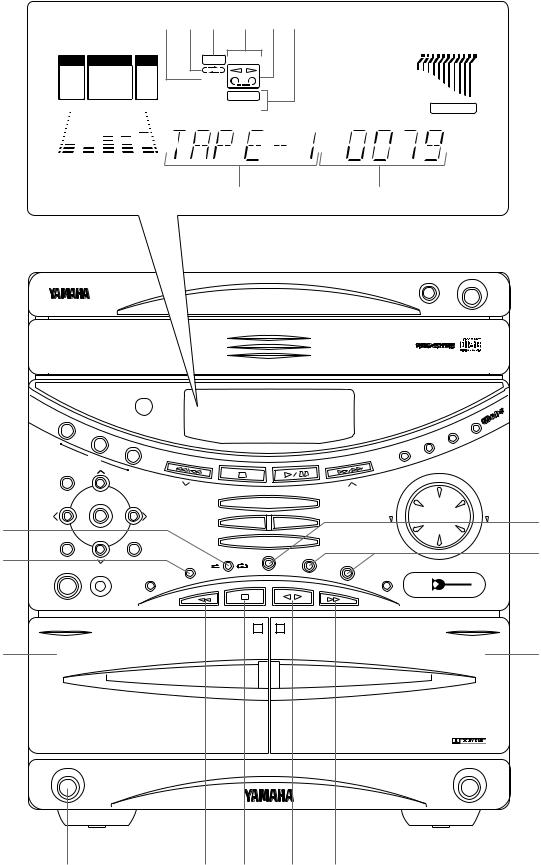
3
P Q R S TU
MUSIC LOCATION USER |
REC TAPE 1 2 |
ARENA |
|
 B
B
DUBBING |
|
NOR HIGH |
VOLUME |
|
|
|
KHZ |
100 350 1K 3.5K 10K
V W
1
2
DISC
LOCATION
MUSIC
Z
USER
[
POWER
PHONES
\
EJECT
]
Illustration: Europe model Illustration: Modèle pour l’Europe
|
PTY |
SEEK |
|
DISPLAY |
|
|
|
||
|
|
|
START |
|
3 |
MODE |
|
EDIT |
|
|
|
|
||
|
PS/PTY/RT/CT REPEAT |
|
|
|
|
FREQ |
|
|
|
|
RANDOM |
|
VOLUME |
|
PRESET/TUNING |
A/B/C/D/E |
|
|
|
|
CD |
|
|
|
|
DOWN |
|
|
UP |
TUNER |
AUX |
|
|
G |
BAND
MEMORY
TAPE 1/2 |
|
|
|
REC/PAUSE |
NORMAL |
F |
|
MODE |
|
||
|
HIGH |
||
DOLBY NR |
|
|
|
|
|
DUBBING |
|
TIMER REC |
|
|
|
AUTO/MAN’L |
|
|
MEMORY |
|
|
|
Active Servo |
|
|
|
Technology |
TIMER |
|
|
TIME ADJ |
HOUR |
|
MIN |
|
PLAYBACK 1 |
2 REC/PLAYBACK |
|
|
E
EJECT
^ A B C |
|
|
D |
||
7
Downloaded from: http://www.usersmanualguide.com/
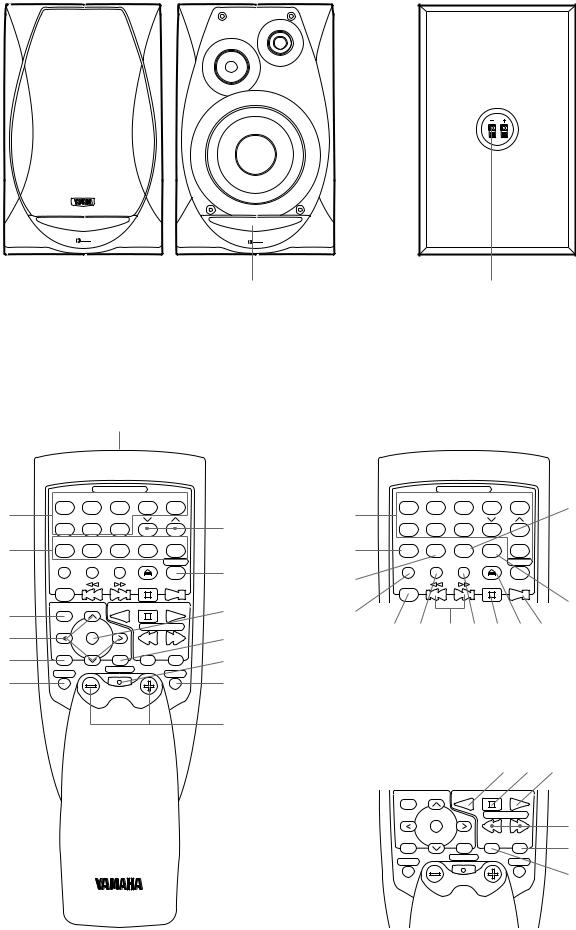
4
Active Servo |
|
Technology |
Active Servo |
|
Technology |
H I
5
2
3
4
5
6
7
1
|
|
CD |
|
|
1 |
2 |
3 |
4 |
5 |
1 |
2 |
3 |
4 |
5 |
6 |
7 |
8 |
PRESET |
|
6 |
7 |
8 |
9 |
0 |
A |
B |
C |
D |
E |
TIME |
PROG |
TAPE |
EDIT |
+I0 |
MODE |
REPEAT |
RANDOM |
OPEN/CLOSE |
TUNER |
DISC SKIP |
|
|
STOP |
PLAY/PAUSE |
LOCATION |
|
PLAY |
STOP |
PLAY |
|
MUSIC |
|
TAPE |
|
USER |
|
FLAT |
REC/PAUSE |
DECK 1/2 |
SLEEP |
|
POWER |
|
INPUT |
|
|
|
||
VOLUME
D
C
B
A 0 9
8
|
|
|
CD |
|
|
|
|
1 |
2 |
3 |
4 |
5 |
Q |
E |
1 |
2 |
3 |
4 |
5 |
|
6 |
7 |
8 |
PRESET |
|
||
|
6 |
7 |
8 |
9 |
0 |
|
F |
A |
B |
C |
D |
E |
|
TIME |
PROG |
TAPE |
EDIT |
+I0 |
|
|
|
MODE |
REPEAT |
RANDOM |
OPEN/CLOSE |
TUNER |
|
G |
DISC SKIP |
|
|
STOP |
PLAY/PAUSE |
|
H |
|
|
|
|
|
P |
|
|
|
|
|
|
|
I J K LM NO
|
|
R S T |
|
|
LOCATION |
PLAY |
STOP |
PLAY |
|
|
MUSIC |
TAPE |
|
|
|
|
|
|
U |
USER |
FLAT |
REC/PAUSE |
DECK 1/2 |
V |
SLEEP |
POWER |
|
INPUT |
|
|
|
|
||
|
VOLUME |
|
|
W |
8
Downloaded from: http://www.usersmanualguide.com/
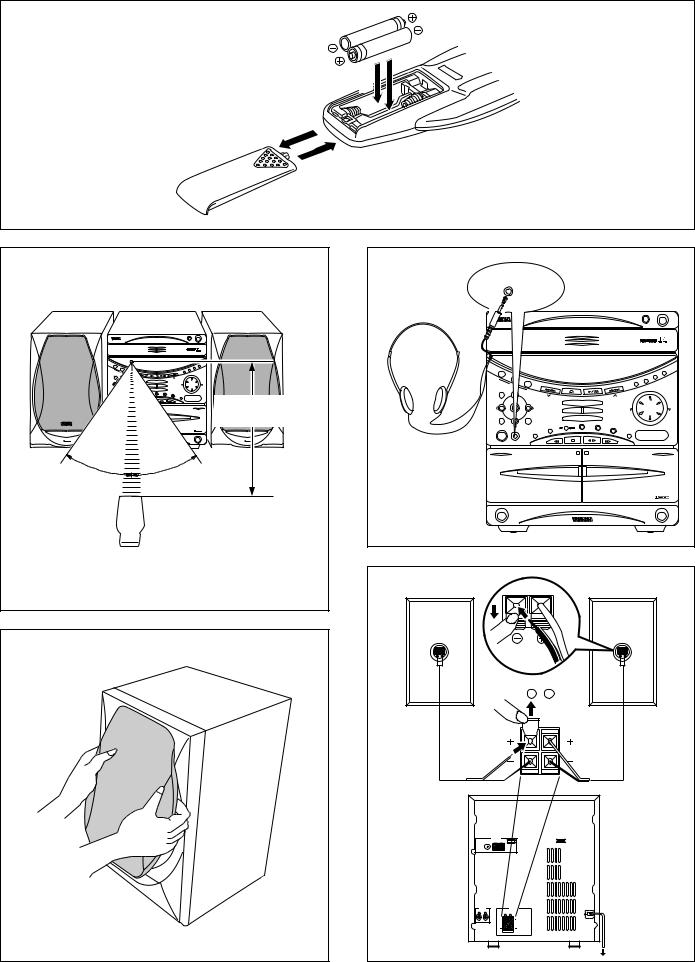
6 |
|
|
|
|
|
|
|
|
|
|
|
|
2 |
|
|
|
|
|
|
|
|
|
|
1 |
|
|
|
|
|
|
|
|
|
|
3 |
|
|
|
|
|
|
|
|
7 |
|
9 |
|
|
|
|
|
|
|
|
|
|
|
|
PHONES |
|
|
|
|
||
|
|
|
|
|
|
|
|
|
DISC CHANGE |
|
|
|
|
|
|
|
|
|
|
|
OPEN/CLOSE |
|
|
|
|
|
|
|
|
|
|
DISPLAY |
|
|
|
|
|
|
|
|
|
|
EDIT |
|
|
|
|
|
|
|
|
|
|
REPEAT |
|
|
|
|
|
|
|
|
|
RANDOM |
VOLUME |
|
|
0.2 m – 6 m |
|
|
|
|
PRESET/TUNING |
|
A/B/C/D/E |
|
|
|
|
|
|
|
|
CD |
DOWN |
UP |
|
|
|
(8” – 20’) |
|
|
|
|
TUNER |
|
AUX |
|
|
|
|
|
|
|
TAPE 1/2 |
|
|||
|
|
|
|
|
|
REC/PAUSE |
NORMAL |
|
||
|
|
|
|
|
|
|
|
|
HIGH |
|
|
|
|
|
|
|
|
|
|
DUBBING |
|
|
|
|
|
|
|
|
TIMER REC |
|
|
|
|
|
|
|
|
|
|
|
|
MEMORY |
|
|
|
|
|
|
|
|
|
|
TIME ADJ |
|
|
|
|
|
|
|
|
HOUR |
|
MIN |
|
|
30° |
|
|
|
|
|
PLAYBACK 1 |
2 REC/PLAYBACK |
|
|
|
30° |
|
|
|
|
|
|
|
|
|
|
|
|
|
|
|
|
|
|
|
|
|
|
|
|
|
|
EJECT |
|
|
|
EJECT |
|
|
0 |
|
|
|
|
|
|
|
|
8 |
|
|
|
|
|
|
|
|
|
|
|
|
|
|
|
|
R |
L |
|
|
|
|
|
|
|
ANTENNA |
|
|
|
|
|
|
|
|
|
FM |
GND |
AM |
|
|
|
|
|
|
|
|
75Ω UNBAL. |
|
|
|
|
|
|
|
|
|
|
INPUT |
|
|
SPEAKERS |
|
|
|
|
|
|
|
AUX |
|
|
|
|
|
|
|
|
|
R |
L |
|
|
|
|
|
|
|
|
|
|
|
|
R |
L |
|
|
|
|
|
|
|
|
|
|
SINCE THIS UNIT |
|
|
|
|
|
|
|
|
|
|
HAS AN ACTIVE |
|
|
|
|
|
|
|
|
|
|
SERVO CIRCUIT |
|
|
|
|
|
|
|
|
|
|
BUILT–IN. |
|
|
|
|
|
|
|
|
|
|
DO NOT CONNECT |
|
|
|
|
|
|
|
|
|
|
IT TO SPEAKERS |
|
|
|
|
|
|
|
|
|
|
OTHER THAN |
|
|
|
|
|
|
|
|
|
|
NX–GX50. |
|
|
|
|
9
Downloaded from: http://www.usersmanualguide.com/
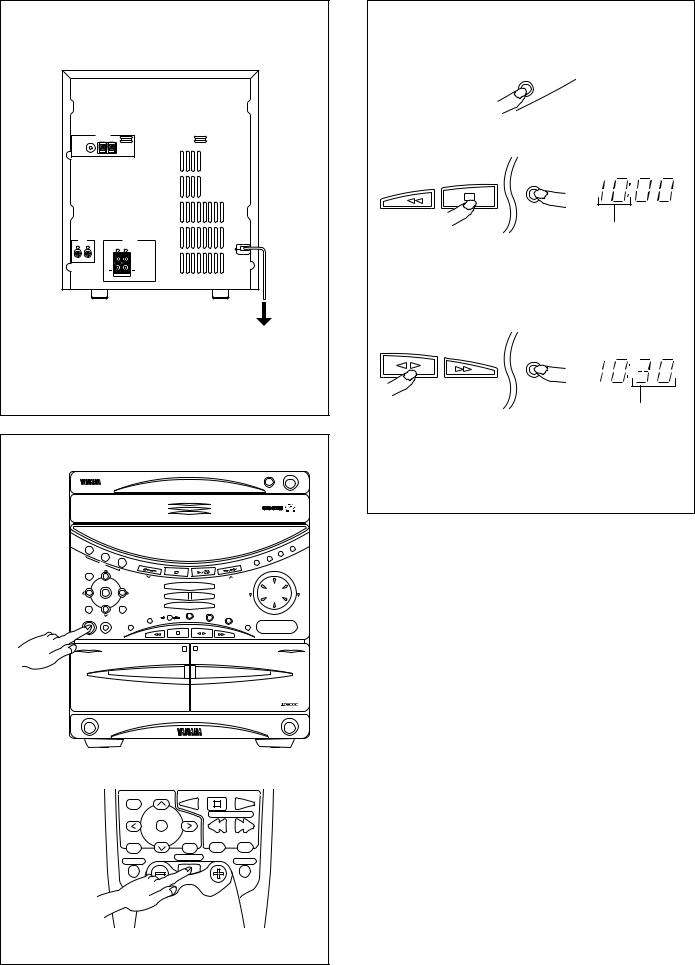
A
|
ANTENNA |
|
FM |
GND |
AM |
75Ω UNBAL. |
|
|
INPUT |
SPEAKERS |
AUX
R L
R L
SINCE THIS UNIT
HAS AN ACTIVE
SERVO CIRCUIT
BUILT–IN.
DO NOT CONNECT
IT TO SPEAKERS
OTHER THAN
NX–GX50.
6ΩMIN./SPEAKER
B
MINI COMPONENT SYSTEM
GX–50
1
|
2 |
|
|
DISC |
3 |
LOCATION |
|
|
|
MUSIC |
|
USER |
|
MEMORY |
|
|
DOLBY NR |
POWER |
PHONES |
|
|
|
AUTO/MAN’L |
|
|
TIMER |
|
C |
|
1 |
|
DISPLAY |
|
2 |
|
MEMORY |
|
Changes. |
|
Change |
|
verändert sich |
|
Ändras |
|
Cambia |
|
Cambia |
|
Verandert. |
|
3 |
To AC outlet |
|
Vers la prise c.a. |
MEMORY |
|
MIN |
|
Changes. |
|
Change |
|
verändert sich |
|
Ändras |
|
Cambia |
DISC CHANGE |
Cambia |
OPEN/CLOSE |
Verandert. |
|
PTY |
SEEK |
|
DISPLAY |
|
|
|
START |
|
|
MODE |
|
EDIT |
|
|
PS/PTY/RT/CT REPEAT |
|
|
|
|
FREQ |
|
|
|
|
RANDOM |
|
VOLUME |
|
PRESET/TUNING |
A/B/C/D/E |
|
|
|
|
CD |
|
|
|
|
DOWN |
|
|
UP |
TUNER AUX
BAND
|
TAPE 1/2 |
|
|
REC/PAUSE |
NORMAL |
MODE |
|
|
|
|
HIGH |
|
|
DUBBING |
|
TIMER REC |
|
|
|
MEMORY |
|
|
TIME ADJ |
HOUR |
|
MIN |
PLAYBACK 1 2 REC/PLAYBACK
EJECT |
EJECT |
LOCATION |
PLAY |
STOP |
PLAY |
|
MUSIC |
TAPE |
|
USER |
FLAT |
REC/PAUSE |
DECK 1/2 |
SLEEP |
POWER |
|
INPUT |
|
|
||
VOLUME
10
Downloaded from: http://www.usersmanualguide.com/

ENGLISH
INTRODUCTION
Thank you for purchasing this YAMAHA product. We hope it will give you many years of trouble-free enjoyment. For the best performance, read this manual carefully. It will guide you in operating your YAMAHA product.
FEATURES
•45W + 45W (6Ω ) Output Power, 10% THD, 1 kHz
•4 Preset Graphic Equalizer Modes Selectable According to the Music Source
•3-Mode Sound Field Processor (Adding 3- Karaoke Modes for Australia, Singapore and General Models Only)
•4-Equalizer and 4-Sound Field Mode Setting Storage Capability
•2 Microphone Jacks and Mixing Level Control for Karaoke (Australia, Singapore and General Models Only)
•3-Disc Carousel Type CD Changer
•CD Window to Make CD Playback Visible from Outside
•Random Access Programmable CD Playback
•Single Track/Entire Disc/All Disc Repeat Play
•Random-sequence Play
•Automatic Synchronized Recording with CD Playback
•Automatic CD Editing Function for Recording to Tape
•Double Cassette Tape Deck with Automatic Reversing Function
•2-Way Speed Dubbing
•Dolby B Type Noise Reduction System
•40 Station Automatic Preset Tuning
•Multi-Functions for RDS Broadcast Reception (Europe and U.K. models only)
•Multi-Use Timer/Sleep Timer
•Active Servo Processing Speaker System (NX-GX50)
•Automatic Power-Off Function
•Remote Control Capability
CONTENTS |
|
|
Page |
PRECAUTIONS .................................................................. |
2-3 |
SETTING UP THE SYSTEM ................................................. |
3 |
NAMES OF CONTROLS AND INDICATORS .................... |
4-5 |
REMOTE CONTROL TRANSMITTER................................ |
5-6 |
REMOVING THE FRONT GRILLE ........................................ |
6 |
LISTENING WITH HEADPHONES ........................................ |
6 |
CONNECTIONS .................................................................. |
7-8 |
TURNING THE POWER ON/OFF TO THIS SYSTEM ........... |
8 |
SETTING THE CLOCK .......................................................... |
8 |
ADJUSTING BRIGHTNESS OF THE DISPLAY.................... |
9 |
VOLUME CONTROL.............................................................. |
9 |
COMPACT DISC PLAYER OPERATION......................... |
9-16 |
TUNING OPERATION .................................................... |
17-19 |
RECEIVING RDS STATIONS |
|
(U.K. and Europe models only) .................................... |
20-23 |
|
Page |
TAPE DECK OPERATION ............................................ |
24-27 |
RECORDING COMPACT DISCS ................................... |
28-33 |
OTHER RECORDINGS................................................... |
34-35 |
GRAPHIC EQUALIZER/SOUND FIELD PROCESSOR |
|
CONTROL....................................................................... |
36-39 |
KARAOKE OPERATION |
|
(Australia, Singapore and General models only)............. |
40 |
HOW TO USE THE BUILT-IN TIMER............................. |
41-44 |
CONNECTING AN EXTERNAL UNIT.................................. |
45 |
MAINTENANCE ................................................................... |
45 |
TROUBLESHOOTING ......................................................... |
46 |
SPECIFICATIONS................................................................ |
47 |
For basic source play, the following illustrations on top of pages will help you to look for the section you need.
......CD playback ...... |
Tuning |
......Tape playback/recording |
|
E-1
English
Downloaded from: http://www.usersmanualguide.com/

PRECAUTIONS: READ THIS BEFORE OPERATING YOUR UNIT
■This system is equipped with the newly developed Active Servo Processing Speaker System. It is not designed for use with conventional speakers. Therefore, do not attempt to connect other speakers than the provided speaker system.
■Choose the installation location of this unit carefully. Avoid placing it in direct sunlight or close to a source of heat. Also avoid locations subject to vibration and excessive dust, heat, cold or moisture. Keep it away from sources of hum such as transformers and electric motors.
■Do not operate this unit upside-down. It may overheat, possibly causing damage.
■Never open the cabinet. If something drops into the set, contact your dealer.
■Always set the VOLUME control to minimum before starting the audio source: increase the volume gradually to an appropriate level after play has started.
■Do not use force on switches, controls or connection wires. When moving the unit, first disconnect the power plug and the wires connected to other equipment. Never pull the wire itself.
■Do not attempt to clean the unit with chemical solvents; this might damage the finish. Use a clean, dry cloth.
■Be sure to read the “TROUBLESHOOTING” section regarding common operating errors before concluding that the unit is faulty.
■To prevent lightning damage, disconnect the AC power plug and the antenna cable when there is an electrical storm.
■Do not plug the AC power plug to the wall socket before you finish all connections.
■Never allow metallic items (e.g. screwdrivers, tools, etc.) to come near the cassette deck’s record/playback head assembly in this unit. Doing so may not only scratch or damage the head’s mirrorsmooth finish, it may change the magnetic characteristics of the heads, causing a deterioration in reproduction performance quality.
■Although the cassette deck’s record/playback heads used in this unit are high quality heads with outstanding reproduction characteristics, they can become dirty through the use of old tapes or from dust accumulation over time. This can have a serious effect on reproduction quality. Clean the heads regularly with one of the commonly available head cleaners or with cleaning solutions.
■The voltage to be used must be the same as that specified on this unit. Using this product with a higher voltage than that which is specified is dangerous and may result in a fire or other type of accident causing damage. YAMAHA will not be held responsible for any damage resulting from use of this unit with a voltage other than that which is specified.
■The sound level at a given volume setting depends on speaker location and other factors. Care should be taken to avoid exposure to sudden high levels of sound, which may occur when turning on the unit with the volume control setting at high, and to continuous high levels of sound.
■Sudden temperature changes and storage or operation in an extremely humid environment may cause condensation inside the cabinet.
Condensation can cause the unit to malfunction. To eliminate condensation:
•CD pickup
Leave the power on with no disc in the unit until normal playback is possible (about 1 hour).
•Tape head
Leave the power on with no cassette in the unit until normal playback is possible (about 1 hour).
Note
If condensation forms on the tape head, foreign matter may accumulate during use.
•Remote control
Wipe off condensation on the transmitter window with a soft cloth before operating the unit.
IMPORTANT
Please record the serial number of this unit in the space below.
Serial No.:
The serial number is located on the rear of the unit.
Retain this Owner’s Manual in a safe place for future reference.
WARNING
TO REDUCE THE RISK OF FIRE OR ELECTRIC SHOCK, DO NOT EXPOSE THIS APPLIANCE TO RAIN OR MOISTURE.
CAUTION (FOR CANADA MODEL)
TO PREVENT ELECTRIC SHOCK, MATCH WIDE BLADE OF PLUG TO WIDE SLOT AND FULLY INSERT.
FOR CANADIAN CUSTOMER
THIS CLASS B DIGITAL APPARATUS MEETS ALL REQUIREMENTS OF THE CANADIAN INTERFERENCECAUSING EQUIPMENT REGULATIONS.
NOTE
Please check the copyright laws in your country to record from records, compact discs, radio, etc. Recording of copyright material may infringe copyright laws.
The apparatus is not disconnected from the AC power source as long as it is connected to the wall outlet, even if the apparatus itself is turned off.
E-2
Downloaded from: http://www.usersmanualguide.com/
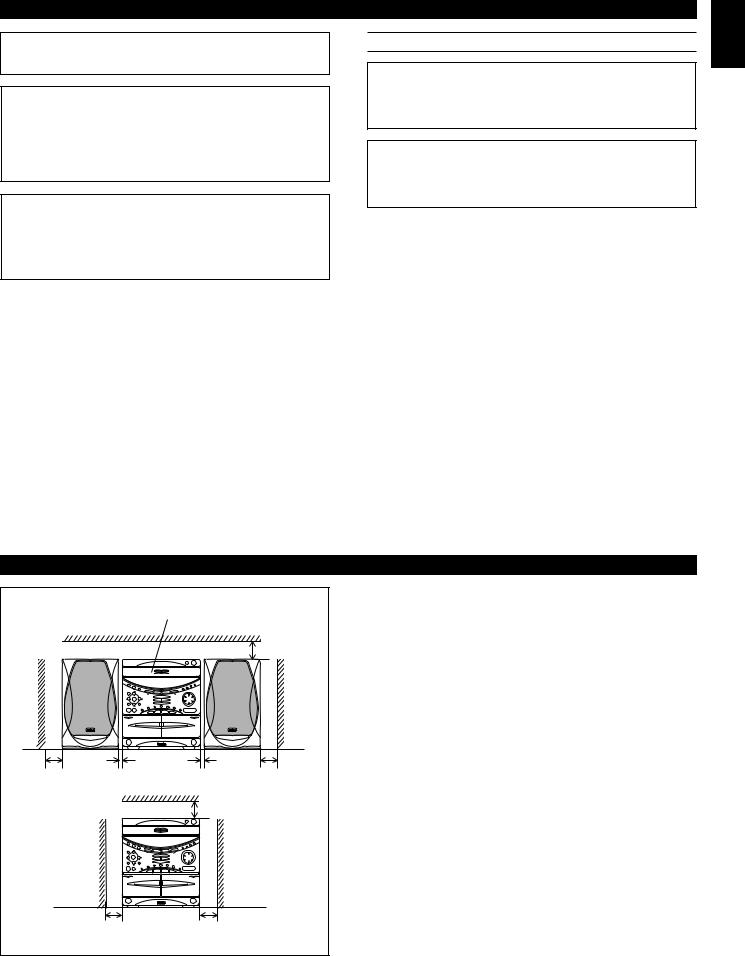
PRECAUTIONS: READ THIS BEFORE OPERATING YOUR UNIT
CAUTION FOR CARRYING THIS UNIT
Be sure not to carry or tip this unit with discs remaining in it.
CAUTION FOR MOVING THIS UNIT
Before moving this unit, first remove all discs from the disc table and close the table by pressing the OPEN/CLOSE button. After you confirm that “no disc” lights up on the display, switch off the power by pressing the POWER switch, and then disconnect the power plug from the AC outlet.
VOLTAGE SELECTOR (General model only)
The voltage selector on the rear panel of this unit must be set for your local main voltage BEFORE plugging into the AC main supply.
Voltages are 110/120/220/240V AC, 50/60 Hz.
WARNING
DANGER
Invisible laser radiation when open and interlock failed or defeated.
Avoid direct exposure to beam.
CAUTION
Use of controls or adjustments or performance of procedures other than those specified herein may result in hazardous radiation exposure.
As the laser beam used in this unit is harmful to the eyes, do not attempt to disassemble the cabinet. Refer servicing to qualified personnel only.
To avoid electrical shock, do not open the cabinet. Refer servicing to qualified personnel only.
DANGER: The use of optical instrument with this product will increase eye hazard.
Laser Diode Properties
•Material: GaAlAs
•Wavelength: 780nm
•Emission Duration: continuous
•Laser Output: max. 44.6µW*
*This output is the value measured at a distance of about 200mm from the objective lens surface on the Optical Pick-up Block.
English
SETTING UP THE SYSTEM
Setup examples |
Main unit |
|
|
|
|
|
|
|
|
|
10 cm |
10 cm |
1 cm |
1 cm |
10 cm |
|
|
10 cm |
|
|
10 cm |
10 cm |
|
Place this system as illustrated on the left and allow spaces more than indicated around the system and more than 10 cm (3-15/16”) behind the system to assure good ventilation. Be sure not to place another unit or any object on top of the main unit to prevent the ventilation holes on the top panel of the main unit from being obstructed. Otherwise, it may cause fire or damage to the main unit.
Notes
•When placing the speakers apart from the main unit, allow a space of at least 10 cm (3-15/16”) above, behind and on the both sides of the main unit.
•If the system is put in a rack, the front of it must be fully opened.
•Disconnect the AC supply lead from the AC outlet before connecting or disconnecting any component.
E-3
Downloaded from: http://www.usersmanualguide.com/
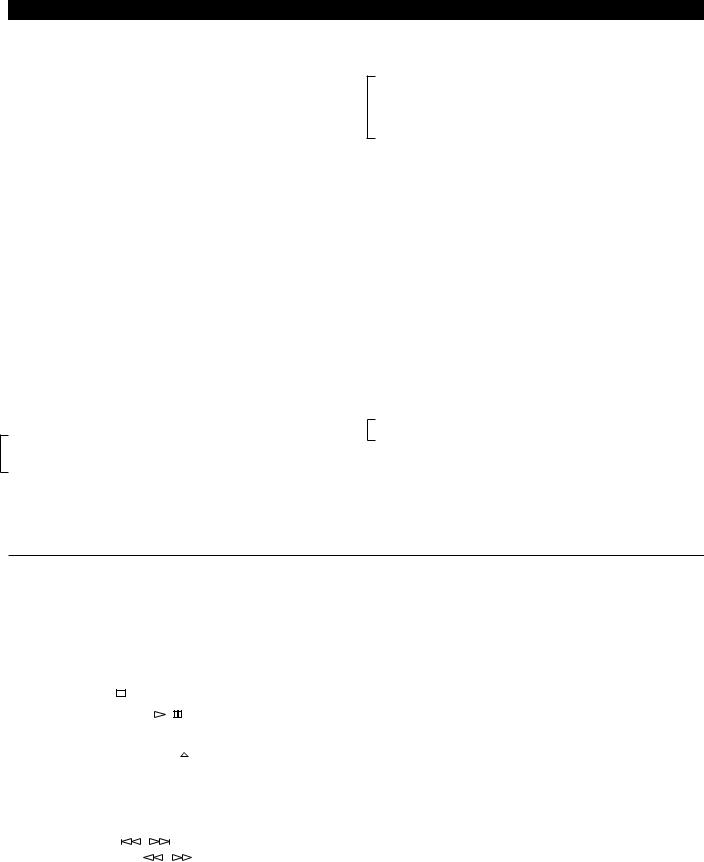
NAMES OF CONTROLS AND INDICATORS
For amplifier/tuner
(See figure 1 on page 5 at the beginning part of this manual.)
1 A/B/C/D/E Button
2 PRESET/TUNING Selector Button
3 Remote Control Sensor
4 LOCATION Button
5 MUSIC Button
6 Equalizer Control Buttons
7 USER Button
8 POWER Switch
9 PHONES Jack
0 User Program MEMORY Button
A AUTO/MAN’L (TIMER) Button
B BAND Button
C HOUR Button
D MIN Button
E TIMER REC Button
F Input Selector Buttons
1G MIC (Microphone) Jacks
*H MIC MIXING (Microphone Mixing) Level Control
I Tuner MEMORY (TIME ADJUST) Button
J VOLUME Control
*2
*2
K (Down)/
(Down)/  (Up) Buttons
(Up) Buttons
LDISPLAY Button
MPTY SEEK START Button
NPTY SEEK MODE Button
OFREQ PS/PTY/RT/CT Selector Button
Display
1 Preset Equalizer Mode Indicator (MUSIC)
2 Sound Field Mode Indicator (LOCATION)
3 User Program Number Indicator
4 MEMORY Indicator
5 STEREO Indicator
6 TUNED Indicator
7 AUTO Tuning Indicator
8 TIMER Set Indicator
9 SLEEP Indicator
0 Volume Level Meter
A Graphic Equalizer Level Meters
B PTY HOLD Indicator
C Preset Number Indicator
D Multi Information Display
(Time, Station Frequency, Volume Level, etc.)
For CD player
(See figure 2 on page 6 at the beginning part of this manual.)
P DISC Selector Buttons
Q Disc Table |
|
|
|
|
|
R Stop Button: |
|
|
|
|
|
S Play/Pause Button: |
/ |
|
|
|
|
|
|
|
|
||
|
|
|
|
||
T DISC CHANGE Button |
|||||
U OPEN/CLOSE Button: |
|
|
|
||
|
|
||||
V RANDOM Button |
|
|
|
|
|
W REPEAT Button |
|
|
|
|
|
X EDIT Button |
|
|
|
|
|
Y Skip Buttons: / |
|
|
|
|
|
(Search Buttons: |
/ ) |
||||
Display
E Music Calendar OVER 15 Indicator
F Music Calendar Indicator
G Tape Side Indicator
H EDIT Indicator
I Program (PROG) Play Indicator
J RANDOM Play Indicator
K Track Number Indicator
L Time Display
M Play Indicator: 
N (S, F) REPEAT Indicator
O Disc Indicator
*21: Provided for Australia, Singapore and General Models Only |
|
* : Provided for U.K. and Europe Models Only |
E-4 |
Downloaded from: http://www.usersmanualguide.com/
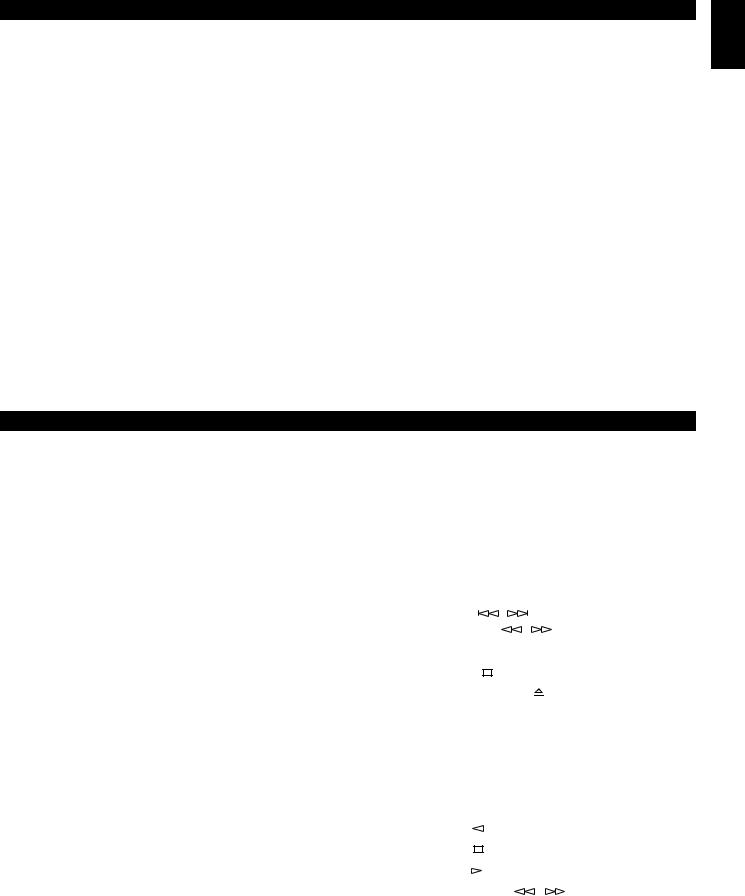
NAMES OF CONTROLS AND INDICATORS
For Tape deck
(See figure 3 on page 7 at the beginning part of this manual.)
Z Reverse MODE Selector Button
[ DOLBY NR Button
\ Deck 1 Cassette Compartment
] Deck 1 EJECT Button
^ Fast Wind Button: 
AStop Button: 

BPlay Button: 

CFast Wind Button: 
DDeck 2 EJECT Button
EDeck 2 Cassette Compartment
FDUBBING (NORMAL/HIGH) Buttons
GREC/PAUSE Button
Display
P Dolby ( 
 ) B NR Indicator
) B NR Indicator
Q Reverse Mode Indicator
R Recording (REC) Indicator
S Tape Number Indicator
T Play Direction Indicator
U DUBBING (NORMAL/HIGH) Indicator
V Tape Number Indicator
W Tape Counter
Speakers (NX-GX50)
(See figure 4 on page 8 at the beginning part of this manual.)
HYST Port
ISpeaker Terminals
REMOTE CONTROL TRANSMITTER
Names of control buttons
(See figure 5 on page 8 at the beginning part of this manual.)
■ Amplifier/tuner control buttons
1 Remote Control Transmitter Window
2 Preset Station Number Buttons
3 A, B, C, D, E Selector Buttons
4 LOCATION Button
5 Equalizer Control Buttons
6 USER Button
7 SLEEP Button
8 VOLUME –(Down)/+ (Up) Buttons
9 INPUT Selector Button
0 POWER Switch
A FLAT Button
B MUSIC Button
C TUNER Input Selector Button
D PRESET Number  (Down)/
(Down)/  (Up) Buttons
(Up) Buttons
■CD player control buttons
E Track Number Input Buttons
F TIME Button
G PROGRAM Button
H Disc Play MODE Selector Button
I DISC SKIP Button
J REPEAT Button |
|
|
K Skip Buttons: |
/ |
|
(Search Buttons: |
/ |
) |
L RANDOM Button
M STOP Button:
N OPEN/CLOSE Button:
O PLAY/PAUSE Button: 


P EDIT Button
Q TAPE Button
■ Tape deck control buttons
R Play Button: |
|
S Stop Button: |
|
T Play Button: |
|
U Fast Wind Buttons: |
/ |
V DECK 1/2 Button |
|
W REC/PAUSE Button |
|
E-5
English
Downloaded from: http://www.usersmanualguide.com/

REMOTE CONTROL TRANSMITTER
Loading the batteries for the remote control transmitter
(See figure 6 on page 9.)
1 Remove the battery compartment cover. (Slide the cover in the direction of the arrow.)
2 Insert 2 “AA” size batteries (UM/SUM-3, R6, HP-7 or equivalent) into the battery compartment.
* Installing the batteries improperly may cause failure.
3 Replace the battery compartment cover.
Precautions for battery use
•Insert the batteries according to the direction indicated in the battery compartment.
•Replace all batteries with new ones at the same time.
•Remove the batteries if they are weak or if the unit is not in use for long periods.
•Don’t mix normal batteries with rechargeable batteries.
Proper use of the remote control transmitter
(See figure 7 on page 9.)
Aim (within the range of 60° with no obstacles) the remote control transmitter at the remote control sensor and operate as shown.
Notes concerning use
•Replace the batteries if control distance decreases or operation becomes unstable.
•Periodically clean the transmitter window on the remote control transmitter and the sensor on the main unit with a soft cloth.
•Exposing the sensor on the main unit to strong light (especially an inverter type of fluorescent lamp etc.) may interfere with operation. In this case, reposition the main unit to avoid direct lighting.
•Keep the remote control transmitter away from moisture, excessive heat, shock and vibrations.
•The remote control transmitter’s usable range is within 0.2m (8”) and 6m (20’) away from the sensor.
REMOVING THE FRONT GRILLE
(See figure 8 on page 9.)
The front grille is fastened to the enclosure at four points, and can be removed if desired. To remove the grille, first hold the bottom of the grille and unfasten the lower part of the grille by pulling it gently, and then hold both sides of the grille and slowly pull straight away from the speaker. To reattach, line up the four pegs on the inside surface of the grille with the four corresponding holes on the speaker and push gently.
Note
When the grille is removed, take care not to touch the speaker units with your hands or to exert excessive force with tools.
LISTENING WITH HEADPHONES
(See figure 9 on page 9.)
•Be sure that your headphones have a 3.5 mm (1/8”) diameter plug and are between 16 ohms and 50 ohms impedance. Recommended impedance is 32 ohms.
•When headphones are connected, the speakers are defeated automatically. Adjust the VOLUME control for desired volume.
E-6
Downloaded from: http://www.usersmanualguide.com/
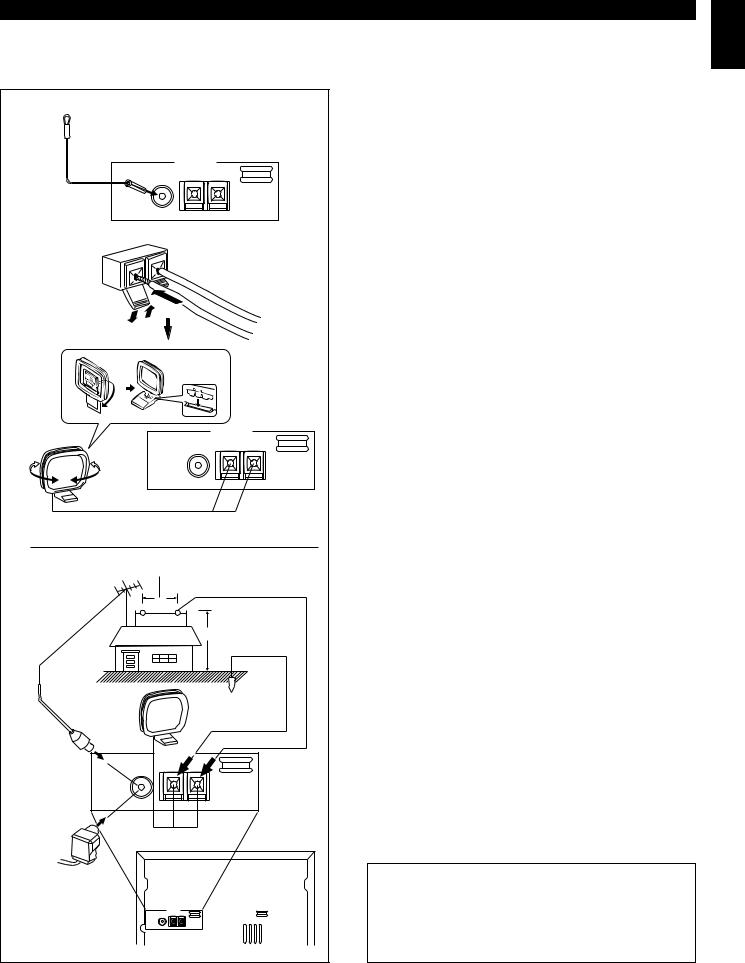
CONNECTIONS
Never plug the AC supply lead of this system into the AC outlet until all connections are completed.
(1) |
|
|
|
|
|
|
ANTENNA |
|
|
FM |
|
GND |
AM |
|
75Ω UNBAL. |
|
|
|
|
(2) |
|
|
|
|
|
|
|
ANTENNA |
|
|
|
FM |
GND |
AM |
|
|
75Ω UNBAL. |
|
|
15 m (49 feet) |
(4) |
|||
|
|
|
|
|
(3) |
|
7.5 m (25 feet) |
||
|
|
|||
|
|
|
Earth rod |
|
ANTENNA |
|
|
||
FM |
GND |
AM |
|
|
or |
|
|
|
|
75Ω UNBAL. |
|
|
|
|
|
ANTENNA |
|
|
|
FM |
GND |
AM |
|
|
75Ω UNBAL. |
|
|
|
|
Antenna connection
(1) Supplied FM antenna
Connect the FM antenna wire to the corresponding terminal and direct the FM antenna wire to the direction where the strongest signal can be received.
(2) Supplied AM (MW/LW) loop antenna
Connect the AM (MW/LW) loop antenna wires to the corresponding terminals. Position the AM (MW/LW) loop antenna for optimum reception. Place the AM (MW/LW) loop antenna on a shelf etc., or install it on the rack or wall with screws (not supplied).
Notes
•When static is still heard even after adjusting the position of the AM (MW/LW) loop antenna, try reversing the wire connections (right to left).
•Do not place the AM (MW/LW) loop antenna on the unit. It will result in noise generation, since the unit is equipped with digital electronics. Place the AM (MW/LW) loop antenna away from the unit.
(3) External FM antenna
Use an external FM antenna instead of an indoor FM antenna if you need better reception. Consult your dealer.
(4) External AM (MW/LW) antenna
Use an external AM (MW/LW) antenna if you need better reception. Consult your dealer.
Note
When using an external AM (MW/LW) antenna, be sure to keep the wire of the AM (MW/LW) loop antenna connected.
FREQUENCY STEP switch (General model only)
Because the interstation frequency spacing differs in different areas, set the FREQUENCY STEP switch (located at the rear) according to the frequency spacing in your area. Before setting this switch, disconnect the AC supply lead of this unit from the AC outlet.
E-7
English
Downloaded from: http://www.usersmanualguide.com/
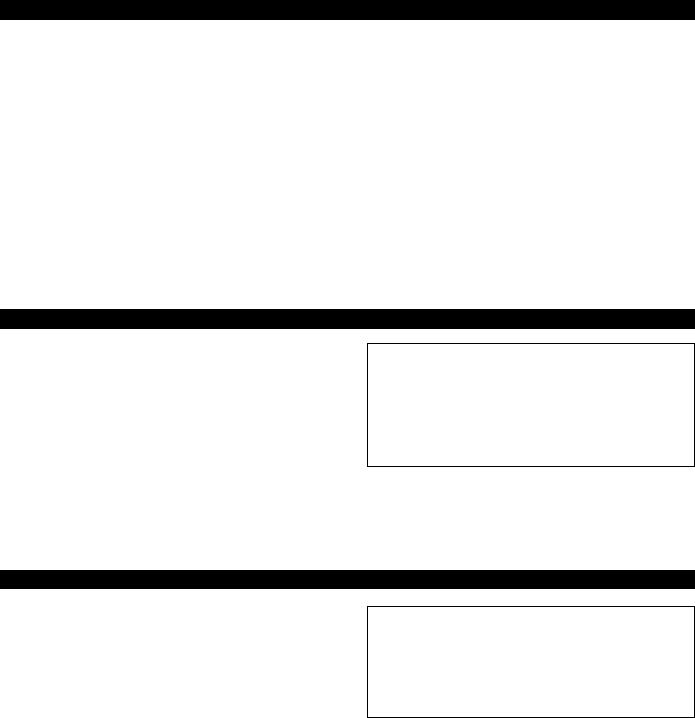
CONNECTIONS
Speaker connection
(See figure 0 on page 9.)
Connect each speaker wire to the SPEAKERS terminals.
Cautions
•Do not let the bare speaker wires touch each other as this could damage the power amplifier and/or speakers.
•When connecting the speakers to the unit, be sure to connect the speaker wires properly. Do not make a mistake from the right channel to the left channel and from the plus (+) terminal to the minus (–) terminal.
•Do not connect these SPEAKERS terminals to speakers other than the provided speaker system NX-GX50.
Connecting the AC supply lead
(See figure A on page 10.)
•After connecting the speakers, plug the AC supply lead into a convenient AC outlet.
•Unplug the AC supply lead from the AC outlet if the unit is not to be used for a long period of time.
TURNING THE POWER ON/OFF TO THIS SYSTEM
(See figure B on page 10.)
If the AC supply lead is connected to the AC outlet, this system can be turned ON and OFF (STANDBY mode) by pressing the POWER switch on the front panel of the main unit or the POWER switch on the remote control transmitter.
Automatic power-off function
The power of this system will be automatically turned off if there is no operation on the control parts of this system, no illumination on the graphic equalizer indicators and no playback of CD or tape for about 30 minutes.
STANDBY mode
While the power is on, pressing the POWER switch (or the POWER switch on the remote control transmitter) switches the system to the STANDBY mode. (In this mode, the display shows only the time.) In this mode, main voltage is still present inside the system. If you want to switch off the system completely, disconnect the AC power plug from the AC outlet.
SETTING THE CLOCK
(See figure C on page 10.)
1 While the power is on, press the DISPLAY button to display the time. If the power is off, you can proceed to the next step.
2 While holding the TIME ADJ button pressed, press the HOUR button and set the hour.
*Press the HOUR button once to advance the time by 1 hour. Press and hold to advance continuously.
*To reverse the hour, press the  button instead of the HOUR button.
button instead of the HOUR button.
3 While holding the TIME ADJ button pressed, press the MIN button and set the minute.
*Press the MIN button once to advance the time by 1 minute. Press and hold to advance continuously.
*The hour setting will not advance even if minute is advanced from “59” to “00”.
*To reverse the minute, press the  button instead of the MIN button.
button instead of the MIN button.
Europe, U.K., Australia and Singapore models use a 24hour display. U.S.A. and Canada models use a 12-hour display shown by “AM (PM) 00:00”. For General model, either the 24-hour display or the 12-hour display is selected depending on the setting of the FREQUENCY STEP switch on the rear panel, so you cannot select a desired type freely.
In the event of a power failure or when the AC supply lead is disconnected.
The time display will go out, however, the clock will function for about 5 minutes without power supply. So you do not have to reset the time if the AC power supply is resumed within about 5 minutes.
When the AC power supply is resumed after more than 5 minutes pass without power supply, the time display will flash on and off to indicate that the time must be reset.
E-8
Downloaded from: http://www.usersmanualguide.com/
